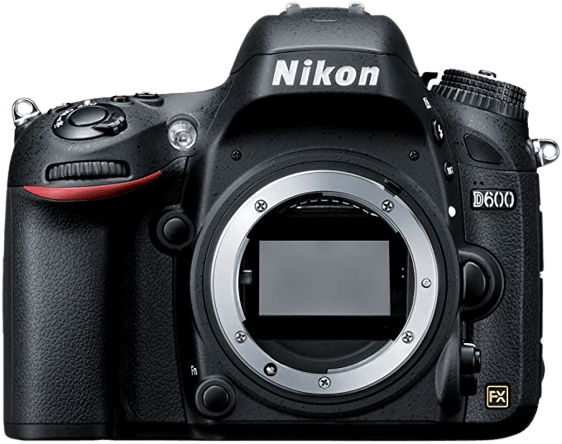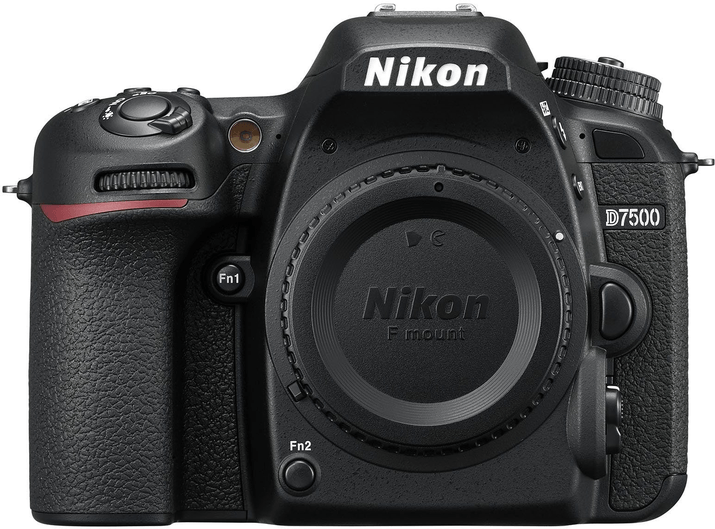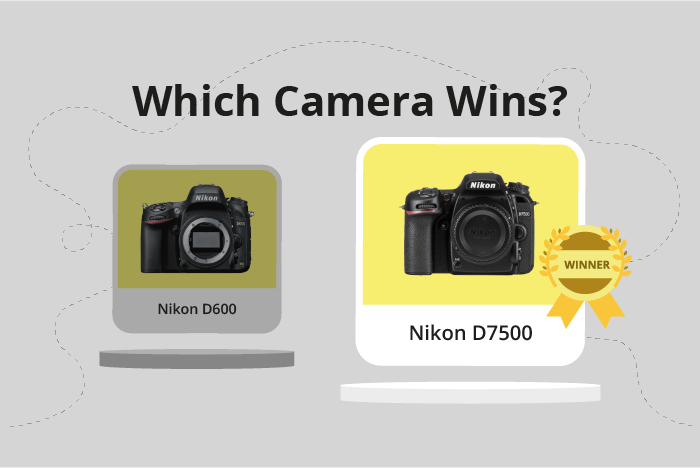Nikon D600 vs D7500 Comparison
Nikon D600

Nikon D7500

The Nikon D7500 emerges as the winner with a score of 70/100, while the Nikon D600 scores 66/100. Both cameras are DSLRs and share a similar launch price range, with the D600 at $2100 and the D7500 at $1250. The D7500 has a slight advantage in size and weight, measuring 136 x 104 x 73mm and weighing 720g, compared to the D600’s 141 x 113 x 82mm and 850g.
The D7500’s higher score reflects its better performance and more advanced features, as it was released in 2017, five years after the D600’s 2012 release. However, the D600 still has its merits, offering a solid performance at a slightly lower price point.
Considering the specs and scores, the Nikon D7500 is a better choice for those seeking a more advanced and lighter camera, while the Nikon D600 remains a reliable option for those on a tighter budget.
Nikon D600 vs D7500 Overview and Optics
The Nikon D600 emerges as the winner in our optics comparison with a score of 70/100, while the Nikon D7500 scores slightly lower at 68/100. Both cameras share several common specifications, such as a CMOS sensor, no image stabilization, and compatibility with Nikon F lens mounts, albeit with different sensor sizes.
The D600 outperforms the D7500 in several aspects. It has a higher megapixel count at 24.3 compared to the D7500’s 20.9, which allows for better image resolution and detail. Additionally, the D600 features a full-frame sensor, which is larger than the D7500’s APS-C sensor. This larger sensor contributes to the D600’s superior DXOMARK score of 94, compared to the D7500’s 86. The full-frame sensor also allows for better low-light performance and a shallower depth of field, making it more suitable for professional photography.
On the other hand, the D7500 has some advantages over the D600. It boasts a faster shooting speed of 8 frames per second, compared to the D600’s 5.5. This makes the D7500 more suitable for capturing fast-moving subjects, such as sports or wildlife. The D7500 is also equipped with a newer Expeed 5 processor, which can lead to faster image processing and potentially improved image quality.
In terms of optics, the Nikon D600 is the better choice for those seeking higher image resolution, better low-light performance, and a shallower depth of field, making it more suitable for professional photography. However, the Nikon D7500 may be more appropriate for those who prioritize capturing fast-moving subjects and desire faster image processing.
Nikon D600 vs D7500 Video Performance
The Nikon D7500 outperforms the Nikon D600 in video capabilities with a score of 70/100, compared to the D600’s 57/100. Both cameras share some common video features, including a maximum video frame rate of 30fps and built-in time-lapse functionality.
The D7500’s superior video performance is due to its 4K video resolution and maximum video dimensions of 3840 x 2160, which are significantly higher than the D600’s Full HD resolution and video dimensions of 1920 x 1080. This advantage allows the D7500 to capture more detailed and sharper footage, making it a more suitable option for videographers seeking top-notch video quality.
On the other hand, the D600 does not offer any distinct advantages over the D7500 in terms of video capabilities. Its Full HD resolution and smaller video dimensions are inferior to the D7500’s 4K capabilities, limiting its potential for capturing high-quality video content.
Considering the differences in video performance, the Nikon D7500 is the clear winner in this comparison. Its 4K video resolution and larger video dimensions provide a significant improvement over the D600’s Full HD capabilities. Videographers and content creators who prioritize video quality should opt for the D7500, while those who are not heavily focused on video capabilities may still find the D600 to be a suitable option.
Nikon D600 vs D7500 Features and Benefits
The Nikon D7500 emerges as the winner in the features comparison with a score of 83/100, while the Nikon D600 scores 57/100. Both cameras share some common specifications, such as a 3.2-inch screen size, screen resolutions of 921,000 and 922,000 dots, and WIFI connectivity. However, the D7500 surpasses the D600 in various aspects, making it the superior choice in terms of features.
The D7500’s advantages include a touchscreen, flip screen, and Bluetooth connectivity. These added features enhance the user experience, providing ease in navigation, flexibility in shooting angles, and seamless connection to external devices. The touchscreen and flip screen are particularly useful for photographers who need to capture images from different perspectives or review photos quickly. Bluetooth connectivity ensures a stable connection to transfer files or control the camera remotely.
On the other hand, the D600 lacks these enhancements, with no touchscreen, flip screen, or Bluetooth. However, it is essential to note that these missing features do not directly impact the camera’s image quality. The D600 can still capture high-quality photos, but the user experience may be less convenient and versatile compared to the D7500.
Considering the specifications and comparing the features, the Nikon D7500 is the better camera. Its added benefits of a touchscreen, flip screen, and Bluetooth connectivity provide an improved user experience and versatility in various shooting scenarios. While the Nikon D600 still captures quality images, the lack of these features makes it less appealing, especially when compared to the more advanced and user-friendly D7500.
Nikon D600 vs D7500 Storage and Battery
The Nikon D600 outperforms the Nikon D7500 in storage and battery with a score of 71/100, compared to the D7500’s 43/100. Both cameras share similarities in storage, accepting SD, SDHC, and SDXC memory cards. However, the D600 has an advantage with two memory card slots, allowing for more storage and better organization of files.
The D7500 has a slightly longer battery life at 950 shots, while the D600 offers 900 shots. Both cameras use a similar battery type, with the D7500 using the EN-EL15a and the D600 using the EN-EL15. Neither camera has USB charging capabilities.
Despite the D7500’s marginally better battery life, the D600’s dual memory card slots make it the superior choice for storage and battery performance. The D7500’s longer battery life may be beneficial in certain situations, but the D600’s overall storage capabilities provide a more practical advantage for photographers.
Nikon D600 vs D7500 – Our Verdict
Are you still undecided about which camera is right for you? Have a look at these popular comparisons that feature the Nikon D600 or the Nikon D7500:

